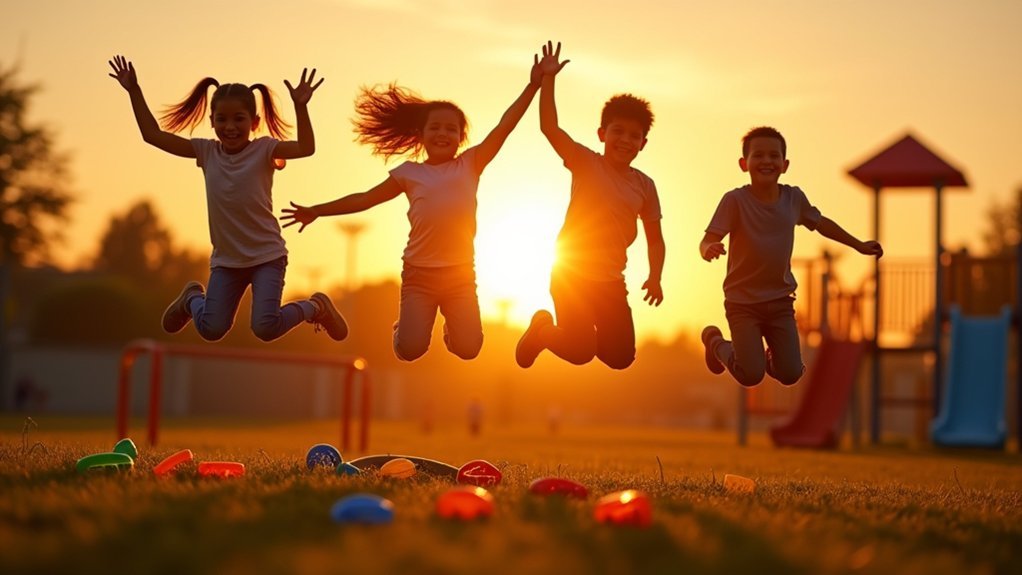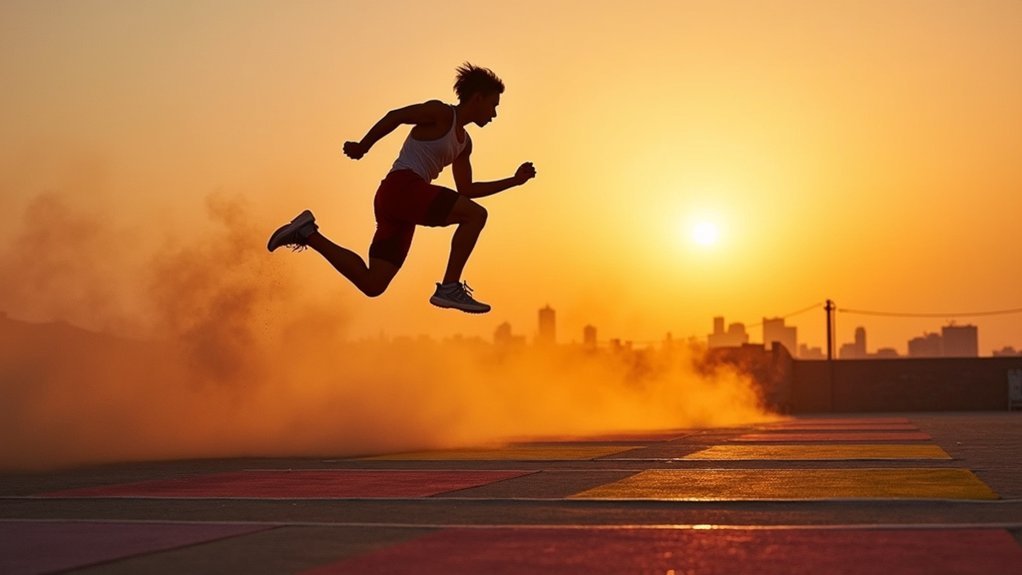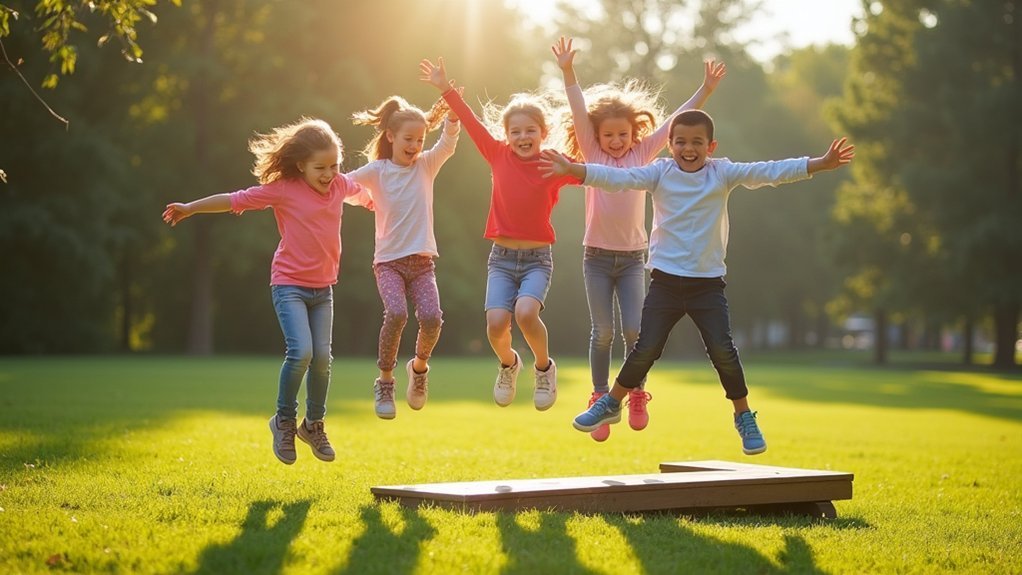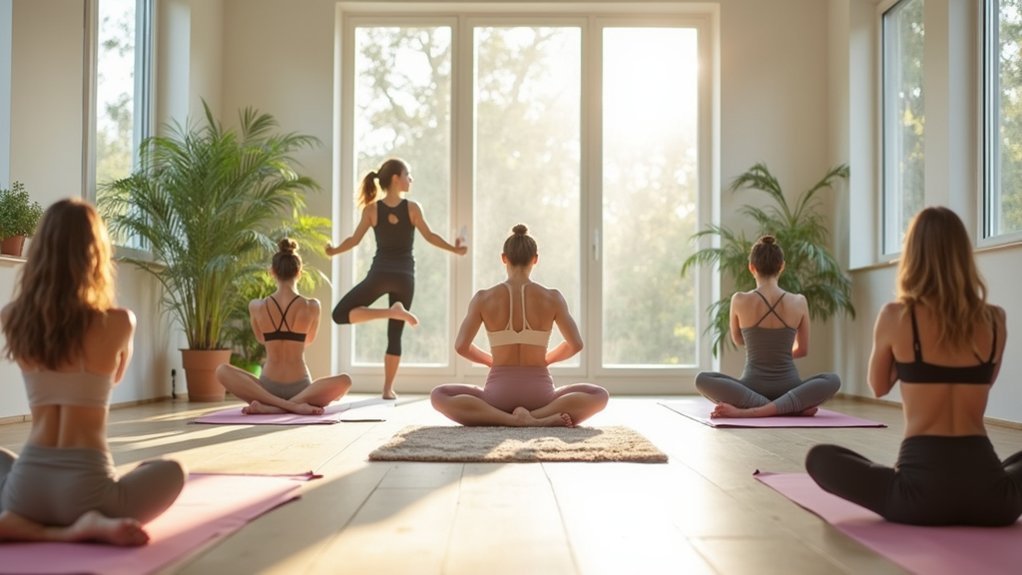To enhance spatial coordination through jumping, start with fundamental box jumps to improve distance gauging. Add progressive twist sequences, gradually increasing rotation difficulty. Practice controlled landings from various heights, focusing on proper knee bending. Try the “Add-On Game” where players build complex jump sequences to boost memory. Develop body awareness by incorporating tuck, pike, and straddle variations during jumps. These techniques will transform your spatial orientation skills as you explore each method further.
5 Tips to Enhance Spatial Coordination Through Jumping

Five fundamental jumping exercises can dramatically improve your spatial awareness and coordination. Start with box jumps, focusing on precise landings in targeted areas. This trains your body to gauge distances accurately while maintaining balance.
Incorporate varied landing techniques—practice both soft landings that absorb impact and dynamic landings that shift into other movements. This versatility enhances your adaptability in space.
Challenge yourself with the “Add-On” game, where you build increasingly complex jump sequences that must be memorized and replicated perfectly.
Memory builds body intelligence. Add-On jumping sequences train your brain to process spatial patterns as naturally as breathing.
Try the “Landing Challenge” either solo or with partners, requiring you to hit specific marks under time pressure.
Finally, regularly change your jump patterns by adding twists and turns to stimulate cognitive processing of movement, helping your brain better map spatial relationships.
Incorporate Progressive Twist Sequences
Building on these foundational jumping exercises, twist sequences offer the next level of spatial coordination training.
Begin with basic jumps to establish proper mechanics before adding a single twist. This gradual approach guarantees your body adapts to the rotational forces while maintaining awareness.
As you gain confidence, progressively increase complexity by adding one twist at a time.
Don’t rush this process—mastery at each stage prevents disorientation during more complex movements.
Utilize visual cues and work with spotters to enhance your focus mid-air.
Practice varied landing techniques to develop precise control throughout the entire movement.
Training with partners provides immediate feedback and encourages experimentation with different twist variations.
This supportive environment allows you to safely push boundaries while refining your spatial coordination through increasingly challenging sequences.
Master Controlled Landings From Various Heights

Mastering controlled landings represents an essential component of spatial coordination that directly impacts your jumping technique and safety.
Begin with low heights using mats or platforms, gradually increasing elevation as your confidence builds.
Focus on proper knee bending to absorb impact—this not only prevents injuries but enhances your spatial awareness during descent.
Practice diverse landing positions: feet together, one foot forward, or in a squat to develop adaptability.
Incorporate visual targets by marking specific landing spots on the ground, which helps refine your precision and body positioning awareness.
To reinforce height-to-landing connections, integrate structured exercises like box jumps or plyometric drills into your routine.
These progressive landing techniques will train your body to instinctively adjust to different heights, markedly improving your overall spatial coordination.
Implement the Add-On Game Challenge
While many traditional exercises focus solely on physical technique, the Add-On Game Challenge transforms spatial coordination training into an engaging social activity with powerful cognitive benefits. As you memorize and replicate growing sequences of tricks, you’ll develop stronger mental-physical connections while improving body control and air awareness.
| Benefits | How It Happens |
|---|---|
| Improved Memory | Remembering increasingly complex sequences |
| Enhanced Body Control | Executing varied movements with precision |
| Increased Confidence | Supportive peer encouragement |
| Creative Expression | Adding unique tricks to differentiate skills |
| Better Endurance | Repeating and building upon sequences |
The collaborative nature of this game creates an environment where you’ll naturally push your limits while having fun. Your spatial coordination improves as you adapt to different tricks and landing styles, making complex movements increasingly intuitive.
Develop Body Awareness Through Position Changes

Three fundamental position changes—tuck, pike, and straddle—form the cornerstone of advanced spatial coordination during jumps. By practicing these variations consistently, you’ll actively engage different muscle groups, enhancing your overall body awareness and control.
Challenge yourself to change positions mid-air, which forces your brain to quickly recalibrate spatial orientation. This practice builds proprioceptive skills—your body’s ability to sense its position without visual cues.
Vary both the height and distance of your jumps to stimulate neurological adaptations that improve coordination during aerial maneuvers.
Integrate these position changes into your Add-On Game sessions to reinforce spatial memory while developing positional awareness. Pay special attention to your landing technique in each position, as this strengthens stability and prepares your body for more complex movements later.
Frequently Asked Questions
How Can I Improve My Coordination in Long Jump?
To improve your long jump coordination, focus on explosive takeoff technique, practice plyometric exercises, try landing accuracy drills, rehearse the full jump sequence regularly, and analyze your jumps through video feedback to make adjustments.
How Can I Improve My Jumping Skills?
Practice specific jumps consistently, adding variety through games like Add-On. Focus on landing technique and turn off overthinking during execution. You’ll develop instinctive responses and better coordination through regular, progressive challenges.
Does Jumping Rope Improve Coordination?
Yes, jumping rope definitely improves your coordination. You’ll develop better hand-foot timing, enhance your proprioception, and strengthen neural pathways as you master the rhythmic movements. It’s an excellent full-body coordination exercise.
Does Jumping Require Coordination?
Yes, jumping definitely requires coordination. You’re synchronizing your muscles, timing your takeoff, controlling your body in the air, and preparing for landing, all while judging distances and maintaining balance throughout the entire movement.
In Summary
You’ve now got five powerful ways to boost your spatial coordination through jumping. As you practice these techniques, you’ll notice improvements in your body awareness, balance, and overall movement quality. Don’t hesitate to adapt these exercises to your skill level and gradually increase difficulty as you progress. Remember that consistency is key—even short jumping sessions can lead to significant coordination gains over time.





Leave a Reply